Blue often associated with sky and water is a rare and beautiful unique color in the world of plants. Plants that are entirely blue or featuring blue foliage color are highly sort after by plant collectors, landscapers and plant enthusiasts for their calming, serene and tranquil effect they generate wherever they are planted or grown.
Though the plants might appear in different shades of blue, from soft to deep navy blue, when grown indoors, these plants not only add a pop of color and visual interest, but they also have numerous benefits, including improving air quality. Most of these plants are also easy to grow and care in any setting.
In this article, I will take you through some of the most popular blue houseplants and highlight their care requirements to help you choose the best one for your home.
List of Blue House Plants
- Blue Agave (Agave Tequilana)
- Blue Hosta
- Blue Pearl Sedum
- Silver Sword Philodendron
- Cebu Blue Pothos
- Blue Bird Echeveria
- Blue Begonia
- Echeveria Blue Metal
- Echeveria Shaviana Truffles
- Blue Chalksticks
- Blue Frills Echeveria
Blue Agave or Agave Tequilana

Blue Agave is an attractive succulent plant that features large, fleshy leaves that grow in a spiral pattern around a central stalk. The leaves are blue-gray to green in color and have a sharp, pointed tip. They are often lined with small teeth or spines along the edges.
It is a slow-growing succulent that can reach up to 4 feet tall, but can be easily kept smaller by pruning or restricting the size of the pot.
The center of the plant usually produce a tall stalk and while in its natural habitat, the stalk can reach up to 6 feet tall, but when grown as a houseplant, it is typically much smaller.
Blue Agave can survive with little water and in a range of lighting conditions, from low to bright light. It is a great choice for a sunny windowsill, but it can also tolerate some shade. Its unique appearance and hardiness make it a great addition to any collection of houseplants.
Blue Hosta
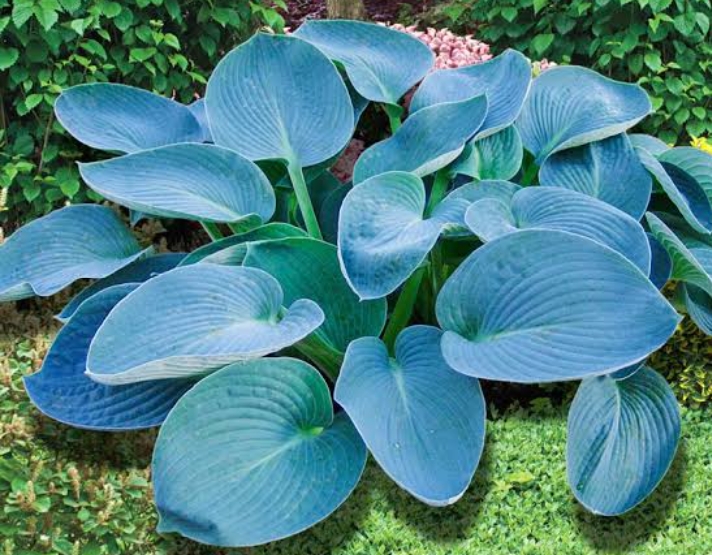
Blue Hosta (Hosta sieboldiana) is a perennial plant a member of the lily family and is native to Asia. Blue Hosta it has attractive, blue-gray leaves that are large and heart-shaped, around 3-8 inches in length.
The leaves of the Blue Hosta are usually glossy and have a slightly wavy texture. They are obviously blue-gray in color color and if cared for well indoors will provide a nice contrast to other indoor plants.
Blue Hosta grows to be around 12-24 inches tall and spreads out to form a clump of leaves. In terms of care, Blue Hosta is easy to grow and care even to those new to indoor gardening. It is also a hardy plant that is resistant to many common garden pests and diseases.
Blue Pearl Sedum
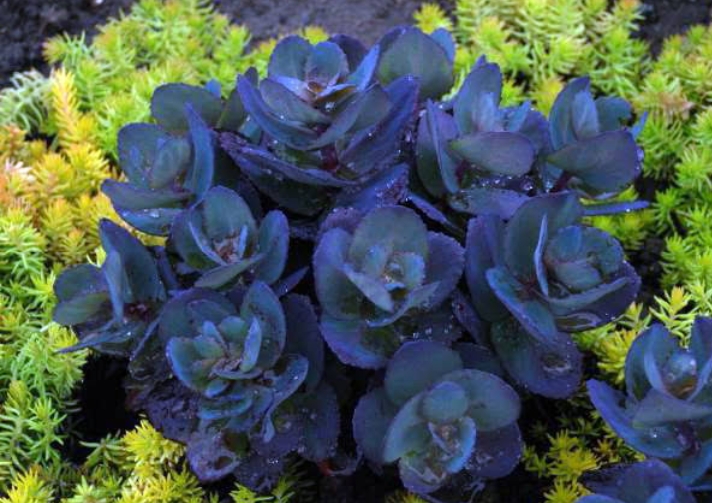
Blue Pearl Sedum (Sedum Blue Pearl) is a succulent plant that belongs to the Crassulaceae family. It’s native to the rocky hills and mountains of Europe and Asia. This plant is a slow-growing, mat-forming with rosettes of blue-grey leaves.
The leaves are fleshy, with a smooth surface and slightly curved shape. The leaves are about 1-2 inches long, and grow in a tight rosette, with a diameter of up to 6 inches.
In the summer, the plant produces clusters of small star-shaped flowers, usually pink or white in color, that are highly attractive to bees and other pollinators.
The flowers form on tall stems that rise above the foliage, adding to the overall height of the plant. The stems can grow to be up to 18 inches tall, but are usually much shorter.
Blue Pearl Sedum is a hardy plant and can grow in a variety of soils, including rocky, sandy, and clay soils. It is drought-tolerant and can survive long periods without water. You use grown the plant in pots or hanging baskets.
This succulen can be propagated easily from stem cuttings and is relatively resistant to most of the garden pests and diseases. To maintain its compact form, it can be trimmed back from time to time.
Silver Sword Philodendron
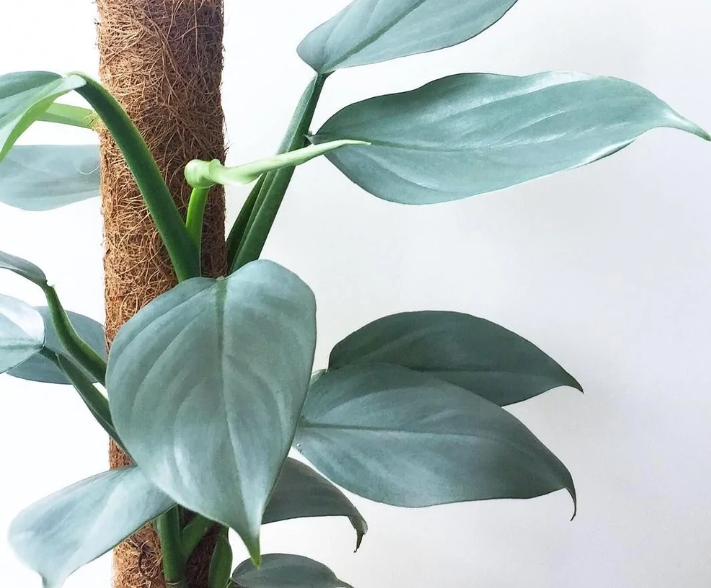
Silver Sword Philodendron (Philodendron bipinnatifidum ‘Silver Sword’) is a a member of the Araceae family. It is native to the tropical rainforests of Central and South America.
The plant is named for its striking, silver-blue colored leaves, which are large, deeply lobed, and grow up to 2 feet long. The leaves are attached to a green stem and grow in an upright, sword-like fashion.
Silver Sword Philodendron is a climbing plant, and will attach itself to supports, such as a tree or a trellis, using aerial roots. It can also be grown as a bush even in indoor container gardening. The plant grows perfectly in a warm, humid environment with bright, indirect light.
Propagation of Silver Sword Philodendron is easily done through stem cuttings. The cuttings should be taken from the top of the plant and allowed to root in water or potting soil. Once rooted, the new plants can be potted and grown as individual specimens.
Silver Sword Philodendron is susceptible to spider mites, mealybugs, and scale insects. Therefore, to prevent these persky insects. You will be required to maintain good hygiene in the growing area, and to regularly check the plant for signs of infestation.
Cebu Blue Pothos

Cebu Blue Pothos is a variety of the Epipremnum aureum species. It has heart-shaped leaves with a blue-green coloration and silver markings.
The leaves are approximately about 5 to 10 inches in size and often with a glossy appearance. The plant produces long trailing stems that can reach several feet in length. The stems can be trained to climb up a support or allowed to trail down from a hanging basket.
This is a fairly popular houseplant especially in North America due to its ease of care and ability to purify the air of toxic pollutants. It can grow in a variety of lighting conditions including low light conditions, but prefers bright, indirect light.
When growing this plant, it is important to know that it needs to be watered regularly to maintain its full appearance. Just allow the soil to dry out slightly between waterings.
This plant is also known to be toxic to pets if ingested, and therefore keeping it out of reach of pets and other animals is best thing to consider when growing it.
The Blue Bird Echeveria

Blue Bird Echeveria is a beautiful and unique succulent, native to the deserts of Mexico. This plant has bright blue-green leaves that form a rosette shape.
The leaves are fleshy, plump and have a glossy finish. The edges of the leaves are slightly curled, which gives the plant a delicate appearance.
Blue Bird Echeveria is a low maintenance plant and is ideal for gardeners who are just starting out with succulents. It is drought-tolerant and can withstand long periods without water.
It grows best in well-draining soil and in a sunny spot. Other than being grown as an indoor plant, It can also be grown and used in rock gardens or as a centerpiece in a succulent garden.
Blue Begonia
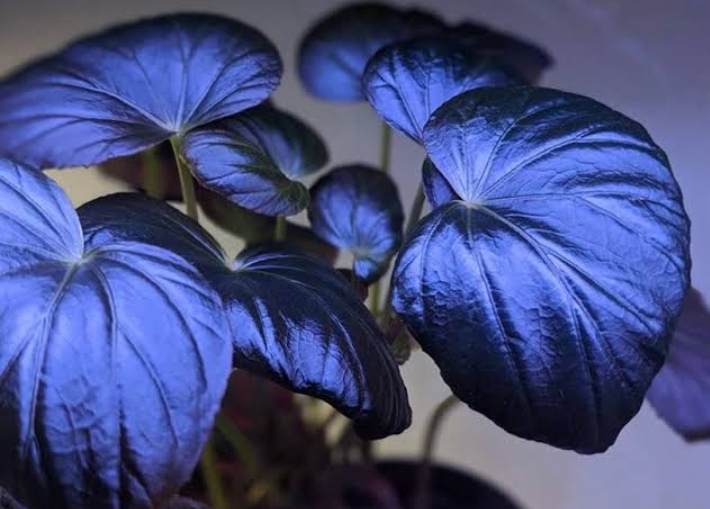
The Blue Begonia is a popular and attractive species of Begonia plant featuring blue leaves. This plant is native to the tropical regions of South and Central America, and it can be grown both indoor and outdoor.
The Blue Begonia has fleshy, bright blue leaves that are covered with a velvety texture. The leaves are oval in shape and are held on long stems that can grow up to 12 inches long. The stems of the Blue Begonia are green and are thin.
In addition to its stunning leaves, the Blue Begonia sometimes produce delicate flowers in shades of pink. The flowers can be seen in the spring and summer months.
The plant generally versatile and can be used for a variety of garden styles. It grows best in well-draining soil and in a spot that gets bright, indirect light. Overall, the Blue Begonia is a beautiful and rewarding plant that adds color and texture to any garden.
Echeveria Caribbean
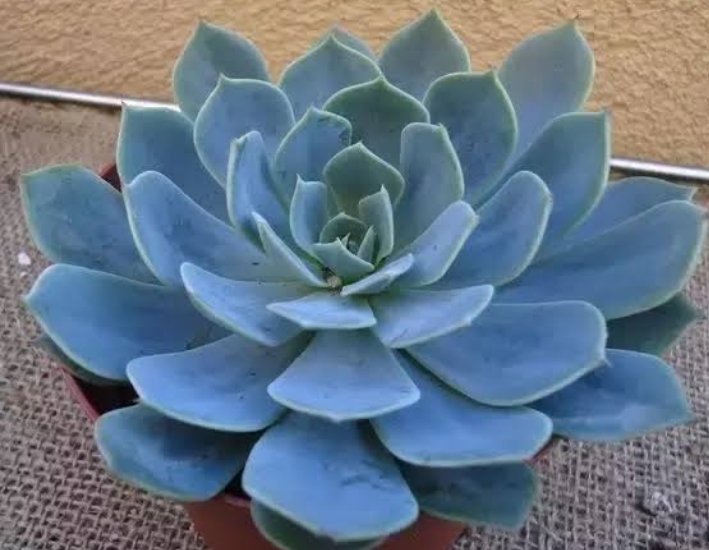
Echeveria Caribbean is a beautiful and unique species of succulent if it’s leaves is anything to go by. This plant is native to Mexico and has rosettes of fleshy, plump leaves that are blue-gray in color. The leaves have a glossy finish and are slightly curled at the edges.
Echeveria Caribbean is a low maintenance plant and is generally ideal for gardeners who are just starting out with succulents or indoor plants.
It grows best in well-draining soil and in a sunny spot, but it can also be grown as a houseplant and is particularly perfect for a succulent garden or a rock garden.
This plant is drought-tolerant and can withstand long periods without water and is essential disease and pest free.
Blue Chalksticks
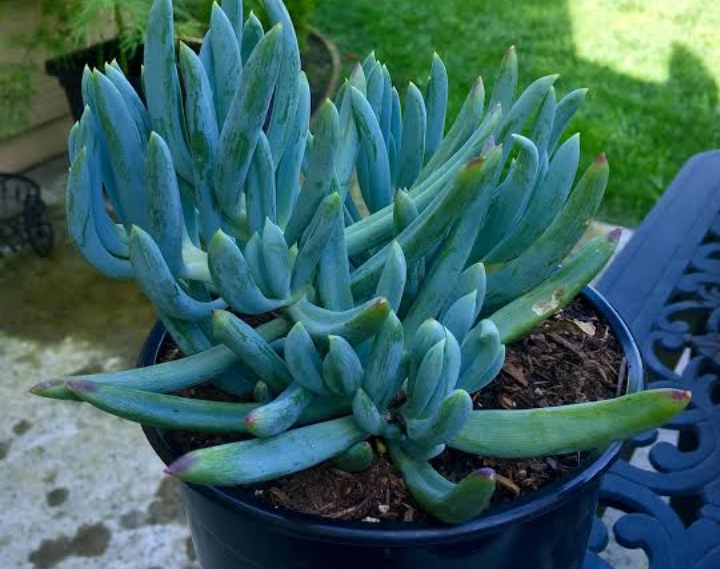
Blue Chalksticks is a beautiful and unique species of succulent that is commonly grown as a houseplant. This plant is native to South Africa and is part of the Aizoaceae family, which includes well-known succulents such as mesembs and ice plants.
It is characterized by its long, narrow, blue-gray leaves that are covered in a powdery white coating. The leaves are arranged in a spiral pattern and are held on thin stems that can grow up to 12 inches long.
Blue Chalksticks grows best in well-draining soil and in a spot that gets bright, indirect light. It is often grown in containers and used for many purposes. This plant is also drought-tolerant and can withstand long periods without water.
Blue Chalksticks also improves the air quality in a room when growing in indoor spaces. It is essentially a good plant for those who want to add a touch of blue to their indoor garden, as its blue-gray leaves provide a striking contrast to the green leaves of other houseplants.
Blue Frills Echeveria
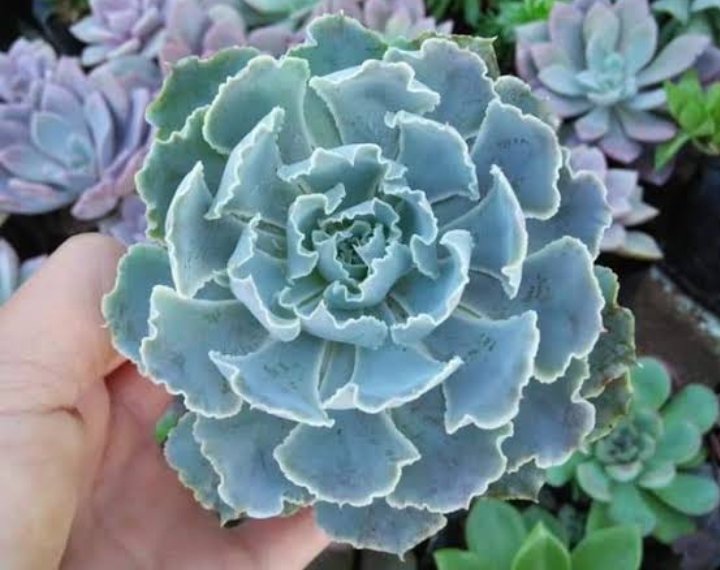
Blue Frills Echeveria as a succulent has a unique and attractive appearance. This houseplant is native to Mexico. It gets its name from its blue-grey, spoon-shaped leaves that are frilly along the edges and form a rosette shape.
This plant is drought tolerant and thrives in warm, well-drained soils. When grown indoors, Blue Frills Echeveria can reaches a height of about 10 inches and a width of about 12 inches.
This plant prefers bright, indirect light and does not need to be fertilized often, but regular watering is important to keep the soil moist.
It is important to know that the plant is prone to root rot if it is kept in overly damp soil. This houseplant can also be propagated easily by cutting a rosette from an adult plant and planting it in fresh soil. With proper care, Blue Frills Echeveria will continue to thrive for many years.